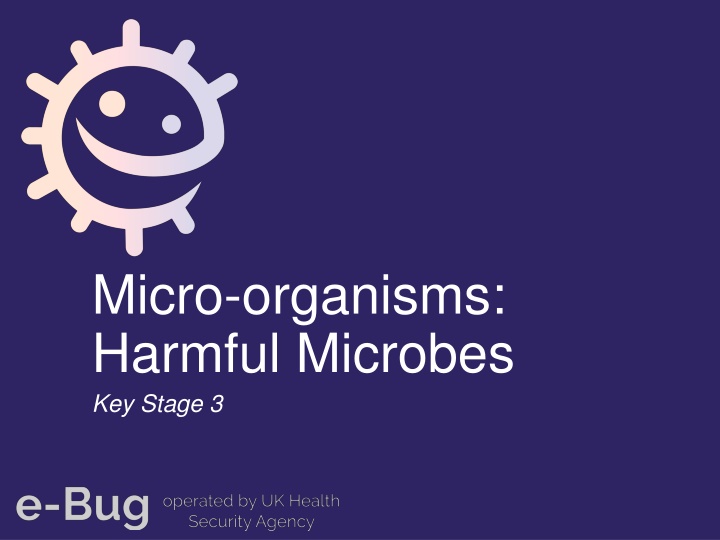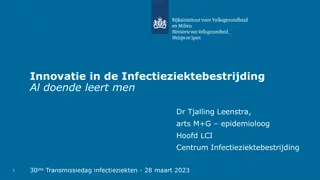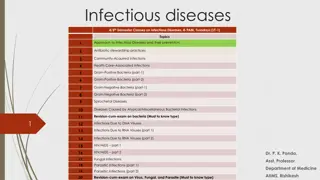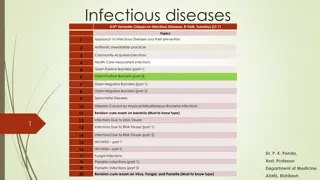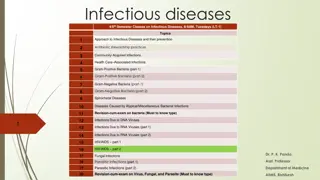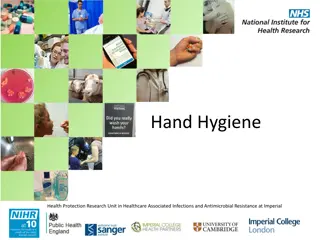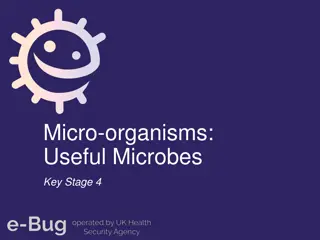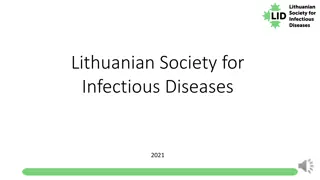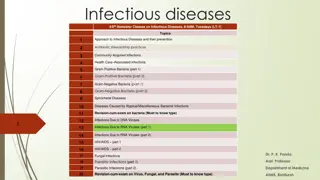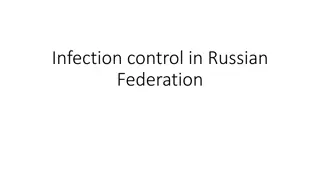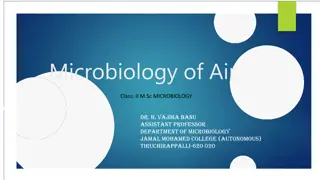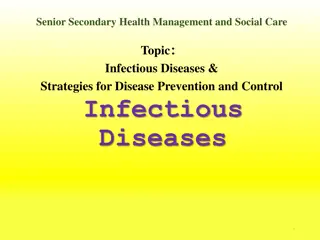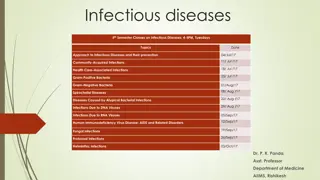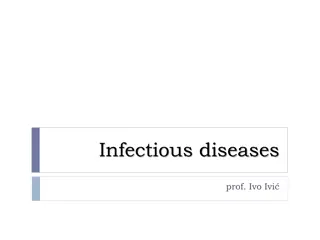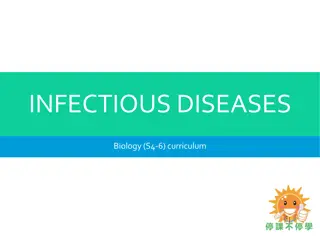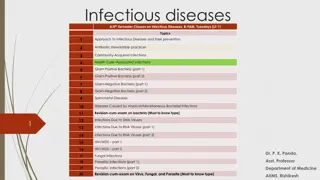Harmful Microbes and Infectious Diseases
Learn about harmful microbes, their effects on humans, and the spread of infectious diseases. Explore the characteristics of infectious diseases and how they are transmitted. Engage in group discussions to understand the impact of global travel on disease spread.
Download Presentation

Please find below an Image/Link to download the presentation.
The content on the website is provided AS IS for your information and personal use only. It may not be sold, licensed, or shared on other websites without obtaining consent from the author.If you encounter any issues during the download, it is possible that the publisher has removed the file from their server.
You are allowed to download the files provided on this website for personal or commercial use, subject to the condition that they are used lawfully. All files are the property of their respective owners.
The content on the website is provided AS IS for your information and personal use only. It may not be sold, licensed, or shared on other websites without obtaining consent from the author.
E N D
Presentation Transcript
Micro-organisms: Harmful Microbes Key Stage 3
Learning Outcomes All students will: Understand that sometimes microbes can make us ill and cause infection. Understand that harmful microbes can pass from person to person. Understand that different infections cause different symptoms. Understand how global travel has influenced the spread of disease. Most students will: Understand how individuals, groups, and organisations work together when responding to infectious diseases outbreaks. e-Bug.eu
Curriculum Links PHSE/RHSE Health and prevention Science Working scientifically Scientific attitudes Experimental skills and investigations Biology Structure and function of living organism Cells and organisation Nutrition and digestion English Reading Writing e-Bug.eu
What are Harmful Microbes? Sometimes microbes can be harmful to humans. Bacteria can produce toxins when they reproduce which are harmful to the body. Viruses enter the body and stick to the cell surface multiplying inside our cells and destroying them. Some fungi like to grow on our skin making it itchy and sore. In the early 1900s the disease of greatest threat was measles; thankfully today we now have a vaccine to prevent this. Bacteria and other microbes that can cause infection and which can spread easily from person to person are called infectious. For example, the difference between an infectious microbe and a non-infectious is the Lactobacilli bacteria we learned about in lesson 2. There are various routes of transmission, for example, touch, water, food, body fluid and air. e-Bug.eu
Main Activity: Infectious Disease Group Discussion e-Bug.eu
1. Discover the different types of infectious diseases caused by harmful microbes and their characteristics 2. By working in groups, fill in the various subheadings (symptoms, transmission, treatment) 3. Present your results to the class e-Bug.eu
Discussion e-Bug.eu
Discussion Points What is a disease? What is an infectious disease? Why do we see infectious diseases that used to be found in a single region, all over the world today? Are all microbes harmful? e-Bug.eu
Extension Activities e-Bug.eu
Fascinating Fact According to the WHO, the top 10 causes of death in 2019 accounted for 55% of the 55.4 million deaths worldwide. Four out of ten were caused by infectious diseases. e-Bug.eu
Disease Match Information Methicillin Resistant Staphylococcus aureus (MRSA) Infectious agent Bacterium: Staphylococcus aureus Symptoms Asymptomatic in healthy individuals. Can cause skin infections, infect surgical wounds, the bloodstream, the lungs, or the urinary tract in previously ill patients. Diagnosis Swab and antibiotic sensitivity test. Mortality rate High if not given the correct antibiotics. Transmission Contagious. Direct skin contact. Prevention Regular hand washing. Treatment Resistant to many antibiotics. While some antibiotics still work, MRSA is constantly adapting. History First reported 1961, increasing problem globally. e-Bug.eu
Disease Match Information Measles Infectious agent Virus: Paramyxovirus Symptoms Fever, runny nose, red and runny eyes, a cough, a red rash and a sore, swollen throat. Blood sample and antibody test. Diagnosis Mortality rate Low, but can be high in lower income countries, where treatment can be hard to access Contagious. Droplets from coughs and sneezes, skin contact or contact with objects that have the live virus on them. Prevention via vaccination. Transmission Prevention Treatment Bed rest and fluid intake. History Virus first reported 1911, has decreased dramatically in high and middle income countries in recent years although small epidemics do occur. Still a pandemic problem for low income countries. e-Bug.eu
Disease Match Information Flu Infectious agent Virus: Influenza Symptoms Headache, fever, chills, muscle aches; possibly sore throat, cough, chest pain. Diagnosis Blood sample and antibody test. Mortality rate Medium but higher in the very young and elderly. Transmission Highly contagious. Inhalation of viruses on airborne particles. Direct skin contact. Prevention Vaccination against current strains. Treatment Bed rest and fluid intake. Antivirals in the elderly. History Present for centuries, epidemics occur at regular intervals. e-Bug.eu
Disease Match Information Thrush Infectious agent Fungus: Candida albicans Symptoms Itching, burning, soreness and white coating of the mouth or irritation of the vagina with a whitish discharge. Diagnosis Swab, microscopic examination and culturing. Mortality rate Transmission None. Person to person contact but is a normal part of the flora of the gut. Symptoms are caused by overgrowth of this fungus due to antibiotics killing off the normal protective bacteria. Therefore avoid unnecessary antibiotic use. Prevention Treatment History Antifungals Almost 75% of all women have had this infection at least once. e-Bug.eu
Disease Match Information Chlamydia Infectious agent Bacterium: Chlamydia trachomatis Symptoms In many cases there are no symptoms but sometimes there is a discharge from the vagina or penis. Swollen testicles and inability to have children can also occur. Diagnosis Swab or urine sample for molecular testing. Mortality rate Rare Transmission Contagious through sexual contact. Prevention Treatment History Use a condom during sexual intercourse. Antibiotics First discovered in 1907. Global problem which is on the increase. e-Bug.eu
Disease Match Information Bacterial Meningitis Infectious agent Bacterium: Neisseria meningitidis Symptoms Headache, neck stiffness, high fever, irritability, delirium, rash. Diagnosis Spinal fluid sample and molecular testing. Mortality rate Medium higher risk in the young and elderly. Transmission Contagious, through saliva and inhalation of droplets. Prevention Vaccination against many strains, avoid contact with infected patients. Treatment Penicillin, oxygen and fluids. History First identified as a bacteria in 1887. Regular epidemics in low income countries. e-Bug.eu
Disease Match Information HIV/AIDS Infectious agent Virus: Human immunodeficiency virus (HIV). Symptoms Failing immune system, pneumonia, lesions. Diagnosis Blood sample and antibody test. Mortality rate Medium high in countries where access to HIV testing and anti-HIV drugs is limited Transmission Highly contagious. Sexual contact, blood to blood contact, sharing of needles, mother to new born transmission. Prevention Always wear a condom during sexual intercourse. Treatment There is no cure although anti-HIV drugs can prolong life expectancy. History First identified in 1983. Currently a global epidemic. e-Bug.eu
Disease Match Information Glandular Fever (Kissing Disease) Infectious agent Virus: Epstein Barr Symptoms Sore throats, swollen lymph glands, extreme tiredness. Diagnosis Blood sample and antibody test. Mortality rate Low Transmission Not very contagious. Direct contact such as kissing and sharing drinks. Prevention Avoid direct contact with infected patients. Treatment Bed rest and fluid intake, paracetamol can be used to relieve the pain. History First described in 1889, 95% population have had the infection, however, only 35% develop symptoms. Occasional isolated outbreaks. e-Bug.eu
Disease Match Information Chickenpox Infectious agent Virus: Varicella-zoster Symptoms Diagnosis Mortality rate Transmission Blistering rash on the body and head. Blood sample and antibody test. Low Highly contagious. Direct skin contact or inhalation of droplets from sneezing and coughing. Prevention Treatment Prevention by vaccine. Bed rest and fluid intake, antivirals in some adult cases. First identified in 1865. Decreased in countries where vaccination programmes have been implemented. No change elsewhere. History e-Bug.eu
Disease Match Information Measles Microbe Virus: Paramyxovirus Symptoms Fever, runny nose, red and runny eyes, a cough, a red rash and a sore, swollen throat. Transmission Spread in coughs and sneezes. Skin contact. Touching objects that have the live virus on them. Prevention Vaccination. Handwashing. Treatment Bed rest and fluid intake. e-Bug.eu
Disease Match Information Flu Microbe Virus: Influenza Symptoms Headache, fever, chills, muscle aches; possibly sore throat, cough, chest pain. Transmission Spread in coughs and sneezes. Breathing in virus in the air. Touching objects that have the live virus on them. Prevention Vaccination against current strains. Treatment Bed rest and fluid intake. Antivirals in the elderly. e-Bug.eu
Disease Match Information Thrush Microbe Symptoms Fungus: Candida albicans Itching. Burning. Soreness. White coating of the mouth or irritation of the vagina with a whitish discharge. Transmission Person to person contact. Prevention The fungus that causes symptoms can grow better when our natural bacteria are killed off. Therefore avoid unnecessary antibiotic use. Treatment Antifungals e-Bug.eu
Disease Match Information Chlamydia Microbe Bacterium: Chlamydia trachomatis Symptoms In many cases there are no symptoms but sometimes there is a discharge from the vagina or penis. Swollen testicles. Inability to have children can also occur. Transmission Sexual contact. Prevention Use a condom during sexual intercourse. Treatment Antibiotics. e-Bug.eu
Disease Match Information Chickenpox Microbe Virus: Varicella-zoster Symptoms Blistering rash on the body and head. Transmissi on Direct skin contact. Spread in coughs and sneezes. Breathing virus in the air. Prevention Vaccination. Handwashing. Treatment Bed rest and fluid intake. Antivirals in some adult cases. e-Bug.eu
Disease Match Worksheet 1.Infectious Microbe Disease Procedure: Bacteria Chlamydia 1. Use the information sheets to find out with diseases should go in each empty box. This has been started for you. 2. Do you notice any similarities or differences between the disease? Virus 1 2 3 Fungi 1 e-Bug.eu
Disease Match Worksheet 2.Symptoms Disease 3.Transmission Disease Asymptomatic 1 Sexual contact 1 2 Fever 1 2 3 Touch 1 2 3 Rash 1 2 Inhalation 1 2 3 Sore throat 1 White discharge 1 2 Mouth to mouth 1 e-Bug.eu
Disease Match Worksheet 5. Treatment Disease 4. Prevention Disease Wash hands 1 2 3 1 2 3 1 2 1 Antibiotics 1 Cover coughs and sneezes Bed rest 1 2 3 Use a condom Avoid unnecessary antibiotic use Antifungals 1 Fluid intake 1 2 3 Vaccination 1 2 3 e-Bug.eu
Disease Match Worksheet 1.Infectious Microbe Disease Bacteria Procedure: 1. Group your disease cards according to the heading in each box. 2. Do you notice any similarities or differences between the diseases based on each of the headings? Virus Fungi e-Bug.eu
Disease Match Worksheet 2.Symptoms Disease 3.Transm- ission Disease Asymptomat ic Fever Sexual contact Rash Blood Sore throat Touch Tiredness Inhalation Lesions Mouth to mouth White discharge e-Bug.eu
Disease Match Worksheet 4. Prevention Disease 5. Treatment Disease Wash hands Antibiotics Cover coughs and sneezes Bed rest Use a condom Antifungals Avoid unnecessary antibiotic use Fluid intake Vaccination e-Bug.eu
Disease Match Worksheet - Answers 1.Infectious Microbe Disease Procedure: Bacteria Chlamydia 1. Use the information sheets to find out with diseases should go in each empty box. This has been started for you. 2. Do you notice any similarities or differences between the disease? Virus Chickenpox Flu Measle Fungi Thrush e-Bug.eu
Disease Match Worksheet - Answers 2.Symptoms Disease 3.Transmission Disease Asymptomatic Chlamydia Thrush Sexual contact Chlamydia Fever Chickenpox Flu Measles Chickenpox Flu Measles Touch Rash Chickenpox Measles Inhalation Chickenpox Flu Measles Sore throat Flu White discharge Mouth to mouth Chlamydia Thrush Flu e-Bug.eu
Disease Match Worksheet - Answers 5. Treatment Disease 4. Prevention Disease Chickenpox Flu Measles Chickenpox Flu Measles Chlamydia Thrush Wash hands Antibiotics Chlamydia Cover coughs and sneezes Bed rest Chickenpox Flu Measles Use a condom Avoid unnecessary antibiotic use Antifungals Thrush Thrush Fluid intake Chickenpox Flu Measles Chickenpox Flu Measles Vaccination e-Bug.eu
Disease Match Worksheet - Answers 1.Infectious Microbe Disease Bacteria Procedure: Bacterial meningitis, Chlamydia, MRSA 1. Group your disease cards according to the heading in each box. 2. Do you notice any similarities or differences between the diseases based on each of the headings? Virus HIV, Chickenpox, Flu, Measles, Glandular fever Fungi Thrush e-Bug.eu
Disease Match Worksheet - Answers 2.Symptoms Disease 3.Transm- ission Disease Chlamydia, MRSA Flu, Measles, Chickenpox, Bacterial meningitis Bacterial meningitis, Chickenpox, Measles Asymptomat ic Fever Sexual contact Chlamydia, HIV, Thrush Rash HIV, Bacterial meningitis Flu, Measles, Chickenpox, MRSA Blood Flu, Glandular fever Sore throat Touch Tiredness Glandular fever Flu, Measles, Chickenpox, Bacterial meningitis Flu, Glandular fever Inhalation Lesions HIV Mouth to mouth White discharge Chlamydia, Thrush e-Bug.eu
Disease Match Worksheet - Answers 4. Prevention Disease 5. Treatment Disease Flu, Measles, Chickenpox, MRSA, Bacterial meningitis Flu, Measles, Chickenpox, Bacterial meningitis Chlamydia, HIV, Thrush Wash hands Antibiotics Chlamydia, Bacterial meningitis, MRSA Cover coughs and sneezes Bed rest Chickenpox, Glandular fever, Measles, Flu Use a condom Antifungals Avoid unnecessary antibiotic use Thrush Thrush, MRSA Fluid intake Chickenpox, Glandular fever, Measles, Flu Vaccination Flu, Chickenpox, Measles e-Bug.eu
Learning Consolidation e-Bug.eu
Write a paragraph or three statements to summarise what you have learned during the lesson. e-Bug.eu
